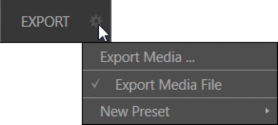
Viz Vectar User Guide
Version 1.0 | Published May 07, 2020 ©
Export Menu
The Export feature’s user interface conforms in large measure to Stream, which we just discussed. Click the Configure gear next to the large Export button in the Dashboard at the top of the screen to open the menu.

At the top (where you would see Web Browser listed in the Stream menu), is an Export Media item. This opens the panel which allows you to manage media files you intend to export. We’ll discuss this panel soon.
Preset List
Below the Export Media menu item is a list of any presets you have configured as Export targets (before you actually create any presets for yourself, this list shows only the default Export Media File entry, a transcoding preset which cannot be deleted).
Notice that each preset listed in the menu can be checked or un-checked. When you add media files to the Export Bin (by any method), the check-marked entries determine which Export targets are automatically assigned to them (you can also manually modify the presets for each item in the Bin at any time).
Tip: When the mouse pointer is over a preset in the Export menu, two gadgets are shown at right; the Configuration (gear) icon allows you to modify the preset, and the X removes it from the list.
New Preset
Let’s consider the New Preset menu item. Click this to display a sub-menu listing various supported Export targets (such as Twitter, or Facebook). Select an item here to open a dialog that lets you create a custom preset that then appears in the list discussed just above.
For most external sites (social media sites or FTP sites), the dialog requires you to enter account credentials. Typically, you need a user name and password for your social media accounts, as well as FTP servers (credentials are tested when you press OK, and report an error if a problem exists).
Social Media Sites
Export can publish media to Facebook, Twitter, YouTube, and many more sites and services. Other connections may be supported as it becomes possible to do so.
Transcode, SMTP, and FTP
The Transcode, FTP and SMTP options let you handle various file conversions and publishing to local (or networked) storage volumes, or even as email. These are very useful output alternatives, effectively providing live export methods that do not force you to wait until production ends. This can be invaluable for collaboration, whether local or remote.
Transcode exports provide options to re-encode video in different formats before sharing. Select suitable options for your target device or application. For SMTP, replace the dummy email server entries with those of your own mail service.
Watermarking
To avoid unauthorized of use private or copyrighted media, you may want to add a watermark before exporting it to public sites. The Watermark feature in the footer of the various Export preset configuration panels allows you to select a suitable overlay image.
The image you select is composited onto exported video or still image files. It should normally be a 32-bit still image file (supported formats include popular formats such as PNG and Targa) that positions the watermark correctly in the frame taking into account the resolution and aspect of exported files.